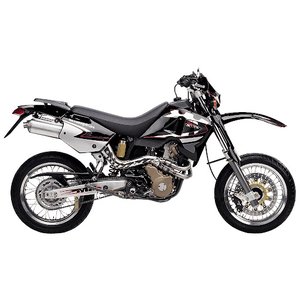Husqvarna SM 610 [2007 - 2010]: The Supermoto That Bridges Street and Dirt

Introduction
The Husqvarna SM 610, produced between 2007 and 2010, is a motorcycle that defies easy categorization. It’s a supermoto at heart – nimble, aggressive, and bred for hooliganism – but with a surprising dose of practicality. This isn’t just a dirt bike with street tires; it’s a machine carefully engineered to balance the raw thrill of motard riding with the demands of daily usability. After spending time with this single-cylinder beast, it’s clear why it developed a cult following among riders who wanted a bike that could carve canyon roads by day and commute to work by morning.
Engine Performance: The Thumping Heart of a Supermoto
At the core of the SM 610 lies a 576cc liquid-cooled single-cylinder engine – a configuration that delivers character in spades. The 98mm bore and 76.4mm stroke (3.9 x 3.0 inches) create a square engine design, contributing to its broad powerband. With 53-54 HP (38.7-40.3 kW) peaking at 7,000 rpm and 52 Nm (38.4 lb-ft) of torque arriving slightly earlier, this engine isn’t about outright speed. It’s about accessible, grin-inducing power that’s always ready to loft the front wheel or snap through traffic.
The 2007-2009 carbureted models (Keihin FCR MX 41mm) offer crisp throttle response, while the 2008-2010 fuel-injected variants (Mikuni digital injection) smooth out low-rev behavior – a welcome upgrade for stop-and-go riding. What’s remarkable is how Husqvarna managed vibration. Despite being a large single, the counter-balancer shaft works overtime. At highway speeds (100-120 km/h or 62-75 mph), vibes are present but never numbing, a testament to the engine’s dual oil pumps and refined internals.
Riding the SM 610 feels like taming a restless animal. The torque curve is meaty between 4,000-6,500 rpm, making third-gear pulls through city streets or mountain passes equally satisfying. It’s not the fastest bike in its class, but the immediacy of its power delivery – especially with the carbureted models – creates a visceral connection that modern throttle-by-wire systems often sanitize.
Chassis and Handling: A Dirt Bike’s Soul in a Street Machine
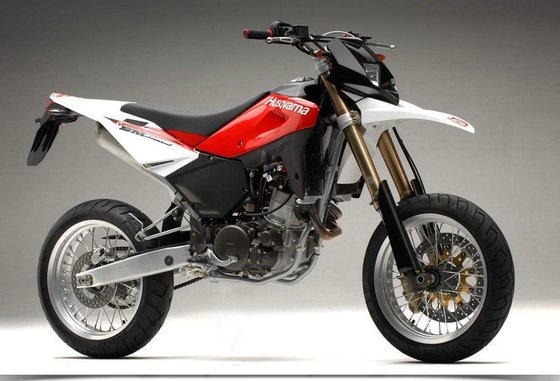
The SM 610’s chassis is where its dual personality shines. The steel single-cradle frame, coupled with a lightweight alloy rear subframe, strikes a balance between flex and rigidity. With a dry weight of 139-142 kg (306-313 lbs), it’s roughly 10-15 kg (22-33 lbs) heavier than purebred motocrossers but remains flickable.
Suspension is premium for the era:
- 45mm Marzocchi USD forks (250mm/9.8in travel) up front
- Sachs Soft Damp shock (290mm/11.4in travel) at the rear
Both ends are fully adjustable, and the setup leans toward the street. Over broken pavement, the SM 610 soaks up impacts like a dual-sport, but dive into a corner hard, and the chassis communicates clearly. The Brembo brakes – a 320mm front disc with four-piston caliper and 220mm rear – provide strong, progressive stopping power. Initial bite isn’t as razor-sharp as modern radial setups, but they’re perfectly matched to the bike’s weight.
Tires are classic supermoto sizes: 120/70-17 front, 150/60-17 rear. The tall 910mm (35.8in) seat height might intimidate shorter riders, but once moving, the narrow seat and central weight distribution inspire confidence. This isn’t a bike you “ride” – it’s one you wear.
Design and Ergonomics: Function Meets (Some) Comfort
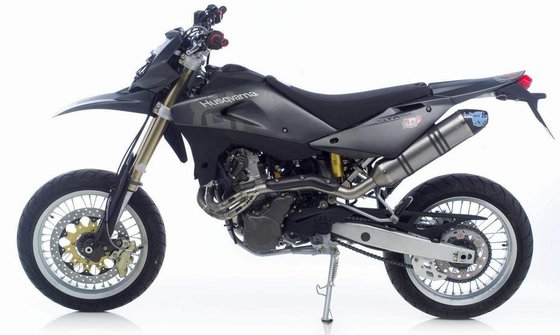
Husqvarna’s design language during this era was unapologetically utilitarian. The SM 610’s angular bodywork, minimalistic LED tail light, and high-mounted front fender scream “race bike.” Yet practical touches abound:
- 12.5L (3.3 US gal) fuel tank with locking cap
- Redesigned seat with dual-density foam (2010 models)
- Optional pannier mounts
The digital dash is basic by today’s standards but effective: speedometer, odometer, trip meter, and warning lights. What’s missing is a fuel gauge – a quirk that forces riders to rely on the trip meter.
Standout features include the USD fork protectors and stainless steel exhaust guard – details that hint at the bike’s durability. Color schemes evolved from the classic red/white (a nod to Husqvarna’s racing heritage) to darker grays in later years, all accented by blacked-out components.
Competition: How the SM 610 Stacks Up
The late 2000s supermoto market was fierce. Here’s how the Husqvarna held its ground:
1. KTM 690 SMC (2008-2010)
- Advantages: More power (64 HP), LC4 engine reliability, ABS (later models)
- Trade-offs: Heavier (146 kg/322 lbs), less agile at low speeds
- Verdict: The KTM is better for long hauls; the Husky feels rawer and more playful
2. Aprilia SXV 5.5 (2006-2010)
- Advantages: V-twin character, race-bred chassis, explosive power
- Trade-offs: High maintenance (desmodromic valves), tiny 7.8L fuel tank
- Verdict: The Aprilia is a track weapon; the SM 610 is the daily rider
3. Yamaha XT660X (2004-2016)
- Advantages: Cheaper to maintain, lower seat (865mm/34in), fuel injection
- Trade-offs: Softer suspension, 48 HP feels lethargic compared to the Husky
- Verdict: The Yamaha is a commuter; the Husqvarna is for thrill-seekers
Where the SM 610 excels is in its jack-of-all-trades nature. It’s competent enough for track days, comfortable (for a supermoto) on highways, and rugged enough for fire roads.
Maintenance: Keeping the Beast Alive
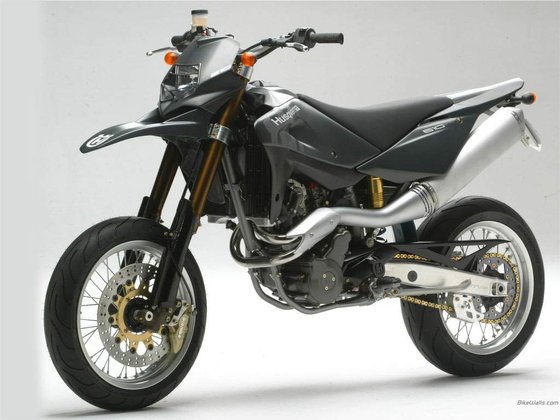
Owning an SM 610 isn’t for the mechanically faint-hearted. Key considerations:
Engine Oil
- Capacity: 2.0L (2.1 US qt) with filter
- Grade: Fully synthetic 10W-60
- Interval: Every 30-40 hours or 5,000 km (3,100 mi)
Valve Adjustments
- Intake/Exhaust Clearance: 0.05mm (0.002in) cold
- Frequency: Every 50 hours or 7,500 km (4,660 mi)
Chain Care
- 112-link chain with 15/45 sprockets
- Adjust tension every 1,000 km (620 mi)
- Lubricate every 500 km (310 mi)
Brake Fluid
- DOT 4 – flush every 2 years
Cooling System
- 1.35L (1.43 US qt) of ethylene glycol coolant
- Replace every 24 months
Pro Tips:
- Upgrade to a high-flow air filter (the stock box is restrictive)
- Monitor clutch cable play on pre-2008 models
- Consider a secondary fuel filter for injected models
Conclusion: A Supermoto That Ages Gracefully

The Husqvarna SM 610 isn’t perfect. It’s vibey, the seat is still a plank by modern standards, and parts availability can be tricky. But these flaws fade when you’re threading through traffic or backing it into a corner. This is a bike that rewards skill and forgives mistakes – a rare combination.
For owners today, the SM 610 represents a golden era of analog supermotos. With basic upgrades (better mirrors, heated grips, or a lithium battery), it transforms into a capable all-rounder. At MOTOPARTS.store, we’ve got the essentials to keep your Husky running sharp: from NGK CPR8E spark plugs to Brembo brake pads. Because machines this special deserve to stay on the road – or better yet, the next twisty backroad that calls your name.

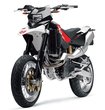

Specifications sheet
| Engine | |
|---|---|
| Stroke: | Four-stroke |
| Max power: | 40 kW | 54.0 hp |
| Max torque: | 52 Nm |
| Fuel system: | Carburetor (Keihin FCR MX 41mm) [2007] or Electronic Fuel Injection (Mikuni) [2008-2010] |
| Max power @: | 7000 rpm |
| Displacement: | 576 ccm |
| Max torque @: | 6500 rpm |
| Configuration: | Single |
| Cooling system: | Liquid cooled |
| Compression ratio: | 11.0:1 |
| Number of cylinders: | 1 |
| Valves per cylinder: | 4 |
| Dimensions | |
|---|---|
| Wheelbase: | 1497 mm (58.9 in) |
| Dry weight: | 140 |
| Seat height: | 910 mm (35.8 in) |
| Overall length: | 2207 mm (86.9 in) |
| Ground clearance: | 245 mm (9.4 in) |
| Fuel tank capacity: | 12.5 L (3.3 US gal) |
| Drivetrain | |
|---|---|
| Gear Ratio: | 1st 2.615 (34/13), 2nd 1.812 (29/16), 3rd 1.350 (27/20), 4th 1.091 (24/22), 5th 0.916 (22/24), 6th 0.769 (20/26) |
| Final drive: | chain |
| Chain length: | 112 |
| Transmission: | 6-speed |
| Rear sprocket: | 45 |
| Front sprocket: | 15 |
| Maintenance | |
|---|---|
| Rear tire: | 150/60-17 |
| Engine oil: | 10W60 |
| Front tire: | 120/70-17 |
| Brake fluid: | DOT 4 |
| Spark plugs: | NGK CPR8E |
| Spark plug gap: | 0.7 |
| Coolant capacity: | 1.35 |
| Engine oil capacity: | 2.0 |
| Engine oil change interval: | Every 5000 km or 2 years |
| Valve clearance (intake, cold): | 0.05 mm |
| Valve clearance check interval: | 24,000 km / 15,000 mi |
| Valve clearance (exhaust, cold): | 0.05 mm |
| Recommended tire pressure (rear): | 2.0 bar (29 psi) solo, 2.2 bar (32 psi) with passenger |
| Recommended tire pressure (front): | 1.8 bar (26 psi) solo, 2.0 bar (29 psi) with passenger |
| Chassis and Suspension | |
|---|---|
| Frame: | Steel single tube cradle with light alloy rear frame |
| Rear brakes: | Single 220 mm disc, Brembo caliper |
| Front brakes: | Single 320 mm disc, Brembo caliper |
| Rear suspension: | Sachs monoshock with Soft Damp linkage, adjustable preload, compression, and rebound |
| Front suspension: | 45mm Marzocchi USD forks, adjustable compression and rebound damping |
| Rear wheel travel: | 290 mm (11.4 in) |
| Front wheel travel: | 250 mm (9.8 in) |



